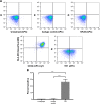Biomarker analysis and clinical relevance of TK1 on the cell membrane of Burkitt's lymphoma and acute lymphoblastic leukemia
- PMID: 28919785
- PMCID: PMC5593407
- DOI: 10.2147/OTT.S141239
Biomarker analysis and clinical relevance of TK1 on the cell membrane of Burkitt's lymphoma and acute lymphoblastic leukemia
Abstract
TK1 is an enzyme involved in DNA synthesis and repair. TK1 is usually found elevated in cancer patients' serum, which makes it a useful tumor proliferation biomarker that strongly correlates with cancer stage, metastatic capabilities, and recurrence risk. In this study, we show that TK1 is upregulated and localizes on the plasma membrane of Burkitt's lymphoma, acute promyelocytic leukemia, T cell leukemia, and acute lymphoblastic leukemia (ALL). Using flow cytometry, we confirmed that TK1 localizes on the surface of Raji, HL60, and Jurkat cell lines and on ALL clinical samples. Using fluorescent microscopy, we found a strong association of TK1 with the plasma membrane in Raji, HL60, and Jurkat cell lines. These findings were also confirmed by scanning electron microscopy. Our study also shows that this phenomenon does not occur on normal resting or proliferating lymphocytes. In addition, we show that membrane TK1 is found in all oligomeric forms ranging from monomer to tetramer and exhibits enzymatic activity. These findings suggest TK1 as a possible target for immunotherapy with the potential to be utilized in the treatment of hematological cancers.
Keywords: ALL; Burkitt’s lymphoma; acute lymphoblastic leukemia; surface antigen; thymidine kinase 1.
Conflict of interest statement
Disclosure The authors report no conflicts of interest in this work.
Figures










Similar articles
-
Evaluation of the upregulation and surface expression of hypoxanthine guanine phosphoribosyltransferase in acute lymphoblastic leukemia and Burkitt's B cell lymphoma.Cancer Cell Int. 2020 Aug 6;20:375. doi: 10.1186/s12935-020-01457-8. eCollection 2020. Cancer Cell Int. 2020. PMID: 32782434 Free PMC article.
-
Membrane expression of thymidine kinase 1 and potential clinical relevance in lung, breast, and colorectal malignancies.Cancer Cell Int. 2018 Sep 10;18:135. doi: 10.1186/s12935-018-0633-9. eCollection 2018. Cancer Cell Int. 2018. PMID: 30214377 Free PMC article.
-
Thymidine kinase 1 as a tumor biomarker: technical advances offer new potential to an old biomarker.Biomark Med. 2018 Sep;12(9):1035-1048. doi: 10.2217/bmm-2018-0157. Epub 2018 Jul 24. Biomark Med. 2018. PMID: 30039979 Review.
-
Human peripheral gamma delta T cells are stimulated by Daudi Burkitt's lymphoma and not by any other Burkitt's lymphoma tested.Cell Immunol. 1994 Jun;156(1):54-61. doi: 10.1006/cimm.1994.1152. Cell Immunol. 1994. PMID: 8200042
-
Thymidine kinase 1 through the ages: a comprehensive review.Cell Biosci. 2020 Nov 27;10(1):138. doi: 10.1186/s13578-020-00493-1. Cell Biosci. 2020. PMID: 33292474 Free PMC article. Review.
Cited by
-
Selection of human single domain antibodies (sdAb) against thymidine kinase 1 and their incorporation into sdAb-Fc antibody constructs for potential use in cancer therapy.PLoS One. 2022 Mar 3;17(3):e0264822. doi: 10.1371/journal.pone.0264822. eCollection 2022. PLoS One. 2022. PMID: 35239730 Free PMC article.
-
Evaluation of thymidine kinase 1 and folate receptor alpha as potential biomarkers in prostate cancer.Sci Rep. 2025 Aug 19;15(1):30380. doi: 10.1038/s41598-025-15375-0. Sci Rep. 2025. PMID: 40830177 Free PMC article.
-
The critical role of serum thymidine kinase 1(STK1) in predicting prognosis for immunotherapy in T4 stage lung squamous cell carcinoma.Heliyon. 2023 Feb 27;9(3):e14129. doi: 10.1016/j.heliyon.2023.e14129. eCollection 2023 Mar. Heliyon. 2023. PMID: 36938402 Free PMC article.
-
Novel monoclonal antibodies against thymidine kinase 1 and their potential use for the immunotargeting of lung, breast and colon cancer cells.Cancer Cell Int. 2020 Apr 16;20:127. doi: 10.1186/s12935-020-01198-8. eCollection 2020. Cancer Cell Int. 2020. PMID: 32317865 Free PMC article.
-
Inhibition of JAK2/STAT3 Signaling Pathway Suppresses Proliferation of Burkitt's Lymphoma Raji Cells via Cell Cycle Progression, Apoptosis, and Oxidative Stress by Modulating HSP70.Med Sci Monit. 2018 Sep 8;24:6255-6263. doi: 10.12659/MSM.910170. Med Sci Monit. 2018. PMID: 30194286 Free PMC article.
References
-
- Sherley JL, Kelly TJ. Regulation of human thymidine kinase during the cell cycle. J Biol Chem. 1988;263(17):8350–8358. - PubMed
-
- Alegre Melissa M, Robison Richard A, O’Neill Kim L. Oncology: Theory & Practice. iConcept Press; 2014. The Clinical Significance and Biology of Thymidine Kinase 1.
-
- Munch-Petersen B. Reversible tetramerization of human TK1 to the high catalytic efficient form is induced by pyrophosphate, in addition to tripolyphosphates, or high enzyme concentration. FEBS J. 2009;276(2):571–580. - PubMed
LinkOut - more resources
Full Text Sources
Other Literature Sources

